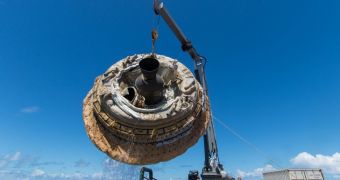This past Sunday, NASA (the National Aeronautics and Space Administration in the United States) announced that, the day before, it had successfully tested a new technology intended to bring astronauts to Mars.
Thus, it was on Saturday, June 28, that the Administration launched a Low-Density Supersonic Decelerator test vehicle from a base on the island of Kauai in Hawaii and then recovered it after it fell in the ocean.
In a press release on the matter at hand, the Administration details that the test took place in the waters off the coast of the United States Navy's Pacific Missile Range Facility on said island, and debuted at 8:45 a.m. HST.
As part of this experiment, a balloon served to carry the vehicle to an altitude of 120,000 feet (36,576 meters). After this, the vehicle's rocket motor kicked into gear and propelled it to an altitude of about 30 miles (48.28 kilometers) at supersonic speeds.
Having completed its powered flight, the test vehicle made its way back to Earth, aided by a doughnut-like tube around it, i.e. the Supersonic Inflatable Aerodynamic Decelerator, that expanded to create drag. It eventually landed in the ocean but was recovered and brought back to shore.
Commenting on the outcome of this test flight, Mark Adler with NASA's Jet Propulsion Laboratory in California said, “We are thrilled about yesterday's test. The test vehicle worked beautifully, and we met all of our flight objectives.”
“We have recovered all the vehicle hardware and data recorders and will be able to apply all of the lessons learned from this information to our future flights,” the project manager to the Low-Density Supersonic Decelerator project added.
As thrilled with the outcome of this test flight as researchers might be, it looks like not everything went according to plan. Thus, the test vehicle's parachute failed to deploy properly, hence the fact that the craft ended up plunging head first in the ocean.
Engineers refused to see this as a failure, but instead consider the incident an opportunity to learn more about how this technology was likely to behave in space. As Dan Coatta put it, “In a way, that's a more valuable experience for us than if everything had gone exactly according to plan.”
“This flight reminds us why NASA takes on hard technical problems, and why we test – to learn and build the tools we will need for the future of space exploration,” added Dorothy Rasco, deputy associate administrator for the Space Technology Mission Directorate at NASA Headquarters in Washington.
By the looks of it, NASA expects to soon carry out two more test flights intended to further investigate the behavior of this technology in Mars-like conditions. Should things go according to plan, the next test flight will take place sometime in 2015.

 14 DAY TRIAL //
14 DAY TRIAL //